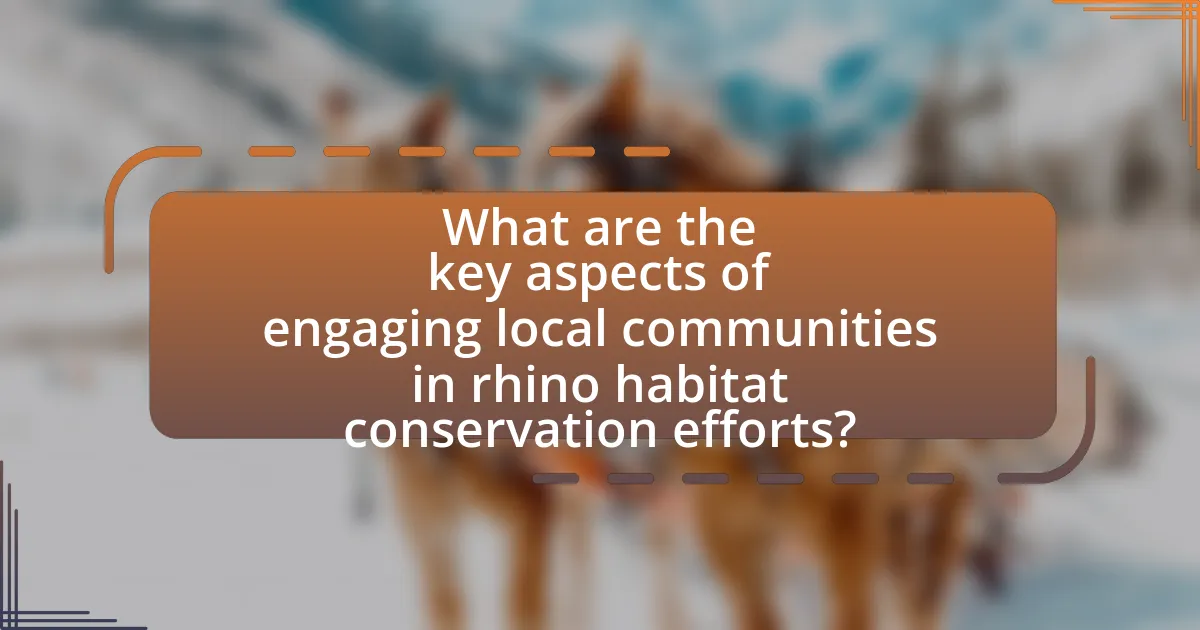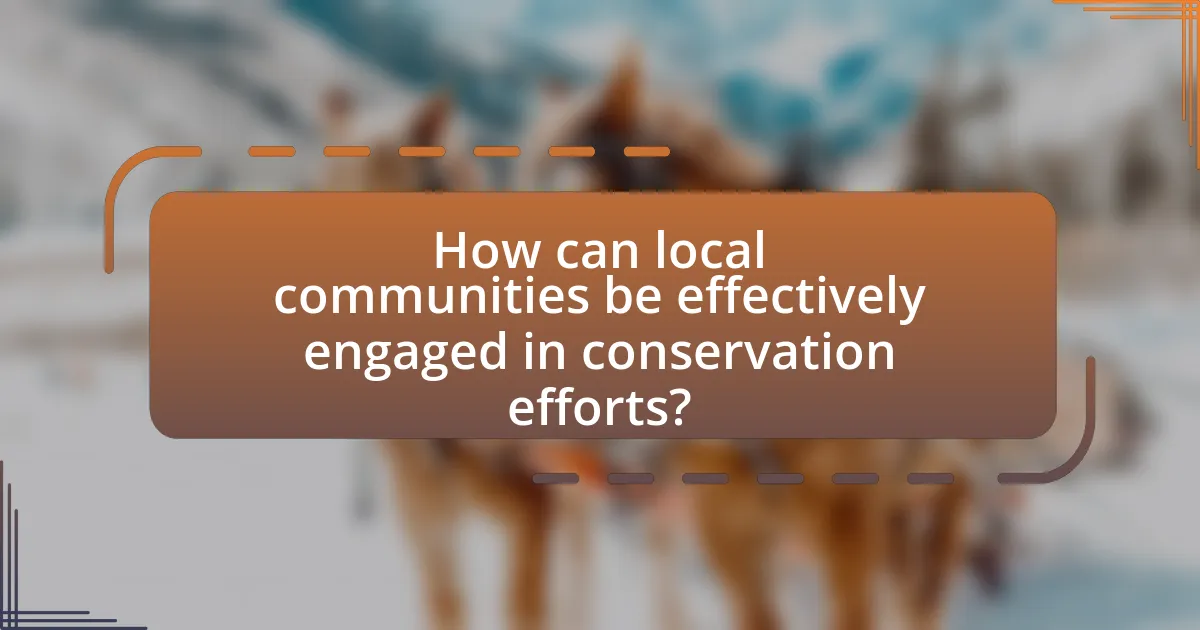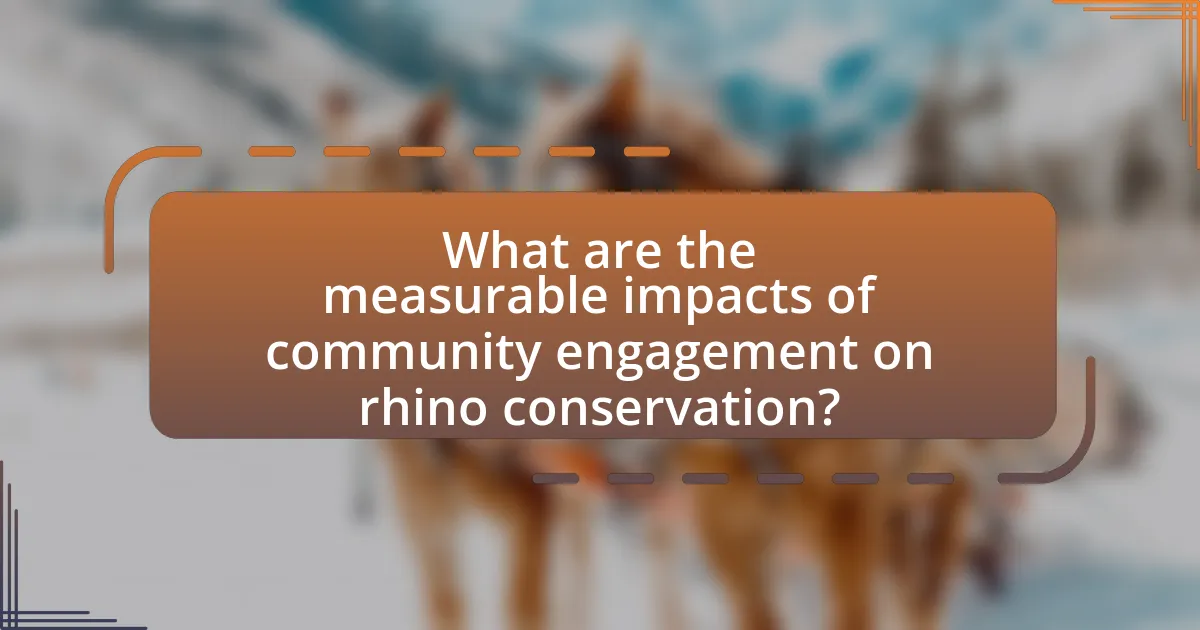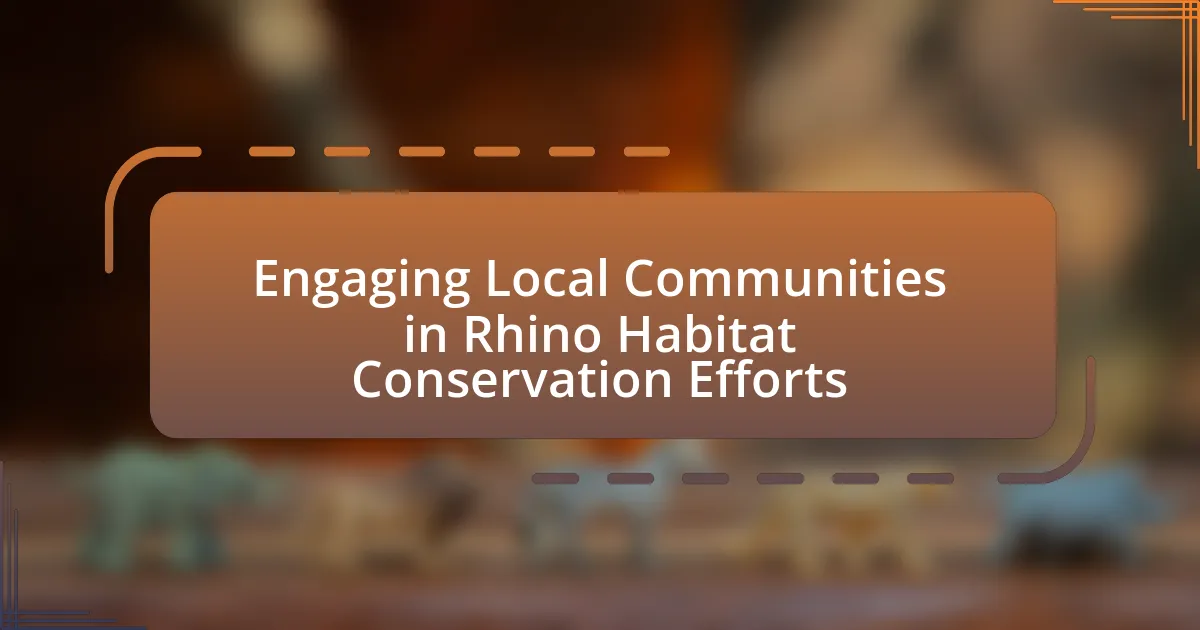The article focuses on engaging local communities in rhino habitat conservation efforts, highlighting key aspects such as collaboration, economic incentives, and education. It emphasizes the importance of community involvement in reducing poaching and fostering stewardship, with examples from successful programs in Namibia and Kenya. The article also addresses challenges faced by communities, including socio-economic barriers and cultural perceptions, while outlining strategies for effective engagement, such as participatory decision-making and educational outreach. Additionally, it discusses the measurable impacts of community engagement on conservation outcomes and best practices for sustaining these efforts.

What are the key aspects of engaging local communities in rhino habitat conservation efforts?
Key aspects of engaging local communities in rhino habitat conservation efforts include fostering collaboration, providing economic incentives, and enhancing education and awareness. Collaboration between conservation organizations and local communities ensures that the needs and knowledge of the community are integrated into conservation strategies, leading to more effective outcomes. Economic incentives, such as eco-tourism and sustainable resource management, motivate communities to protect rhino habitats by demonstrating the financial benefits of conservation. Education and awareness programs empower local populations with knowledge about the ecological importance of rhinos and the threats they face, fostering a sense of stewardship. These approaches have been supported by studies showing that community involvement significantly improves conservation success rates, as seen in various projects across Africa and Asia.
Why is community engagement crucial for rhino conservation?
Community engagement is crucial for rhino conservation because it fosters local stewardship and reduces poaching. When communities are actively involved in conservation efforts, they develop a sense of ownership and responsibility towards the rhino populations and their habitats. Studies have shown that areas with strong community involvement experience lower rates of poaching; for instance, in Namibia, community-based conservation programs have led to a significant increase in rhino populations, demonstrating the effectiveness of local engagement in protecting these species.
What role do local communities play in protecting rhino habitats?
Local communities play a crucial role in protecting rhino habitats by actively participating in conservation efforts and sustainable land management practices. Their involvement often leads to the establishment of community-based conservation programs, which have been shown to reduce poaching and habitat destruction. For instance, in Namibia, community conservancies have successfully increased rhino populations by empowering locals to manage wildlife resources, resulting in a reported 90% reduction in poaching incidents. Additionally, local communities often serve as the first line of defense against illegal activities, utilizing their knowledge of the land to monitor and report threats to rhino habitats.
How does community involvement enhance conservation outcomes?
Community involvement enhances conservation outcomes by fostering local stewardship and increasing awareness of environmental issues. When communities actively participate in conservation efforts, they develop a sense of ownership and responsibility towards their natural resources, leading to more sustainable practices. Research indicates that areas with strong community engagement in conservation initiatives, such as the African Wildlife Foundation’s programs, have seen significant improvements in biodiversity and habitat preservation. For example, local communities in Kenya have successfully reduced poaching rates by 50% through collaborative efforts with conservation organizations, demonstrating the effectiveness of community-driven approaches in achieving conservation goals.
What challenges do communities face in rhino habitat conservation?
Communities face significant challenges in rhino habitat conservation, primarily due to economic pressures, land-use conflicts, and lack of resources. Economic pressures arise when local populations depend on agriculture or livestock for their livelihoods, leading to habitat encroachment. Land-use conflicts occur when communities prioritize development over conservation, often driven by the need for housing or infrastructure. Additionally, many communities lack the financial and technical resources necessary for effective conservation efforts, which hampers their ability to engage in sustainable practices. For instance, a study by the World Wildlife Fund highlights that without adequate support, local communities may resort to poaching or illegal land clearing, further threatening rhino habitats.
What are the socio-economic barriers to effective engagement?
Socio-economic barriers to effective engagement in rhino habitat conservation include poverty, lack of education, and limited access to resources. Poverty restricts communities’ ability to participate in conservation efforts, as individuals prioritize immediate survival over long-term environmental goals. Lack of education diminishes awareness of the importance of conservation, leading to disengagement from initiatives. Limited access to resources, such as funding and technology, hampers community involvement and the implementation of sustainable practices. For instance, a study by the World Wildlife Fund highlights that communities with higher poverty rates are less likely to engage in conservation programs, demonstrating the direct correlation between socio-economic status and participation in environmental efforts.
How do cultural perceptions impact conservation efforts?
Cultural perceptions significantly impact conservation efforts by influencing community attitudes towards wildlife and natural resources. For instance, in regions where rhinos are culturally revered, local communities are more likely to engage in conservation initiatives, viewing them as a means to preserve their heritage. Conversely, in areas where wildlife is seen as a threat to livelihoods, such as agriculture, resistance to conservation efforts can arise. Research indicates that when conservation strategies align with local cultural values, such as integrating traditional practices with modern conservation techniques, the success rate of these initiatives increases. A study published in the journal “Conservation Biology” highlights that community-led conservation programs in Africa, which respect and incorporate local cultural beliefs, have led to a 30% increase in wildlife populations, demonstrating the critical role of cultural perceptions in shaping effective conservation strategies.

How can local communities be effectively engaged in conservation efforts?
Local communities can be effectively engaged in conservation efforts by involving them in decision-making processes and providing education about the ecological and economic benefits of conservation. Research indicates that when communities participate in the management of natural resources, they are more likely to support conservation initiatives. For example, a study published in the journal “Conservation Biology” by Bertram and Vivier (2018) found that community-led conservation programs in South Africa resulted in increased local support for wildlife protection and habitat restoration. Additionally, offering incentives such as eco-tourism opportunities can further motivate communities to actively participate in conservation efforts, as evidenced by successful programs in Namibia that have led to both economic benefits and improved wildlife populations.
What strategies can be implemented to foster community involvement?
To foster community involvement in rhino habitat conservation efforts, strategies such as educational outreach programs, community-based conservation initiatives, and participatory decision-making processes can be implemented. Educational outreach programs raise awareness about the importance of rhinos and their habitats, leading to increased community support; for instance, studies show that communities engaged in educational initiatives are more likely to participate in conservation activities. Community-based conservation initiatives empower local residents by involving them in the management and protection of rhino habitats, which has been proven to enhance local stewardship and reduce poaching incidents. Additionally, participatory decision-making processes ensure that community voices are heard in conservation planning, fostering a sense of ownership and responsibility towards local wildlife. These strategies collectively enhance community engagement and contribute to the success of conservation efforts.
How can education and awareness programs be designed for local communities?
Education and awareness programs for local communities can be designed by incorporating culturally relevant content, engaging local stakeholders, and utilizing interactive methods. Culturally relevant content ensures that the information resonates with the community’s values and practices, which increases engagement and retention. Engaging local stakeholders, such as community leaders and organizations, fosters trust and encourages participation, as these individuals can act as advocates for the program. Interactive methods, such as workshops, hands-on activities, and community events, promote active learning and allow participants to experience the material firsthand. Research indicates that programs tailored to local contexts and involving community input are more effective; for instance, a study by the World Wildlife Fund found that community-led conservation initiatives significantly improved local engagement and conservation outcomes.
What role do local leaders play in mobilizing community support?
Local leaders play a crucial role in mobilizing community support by acting as trusted figures who can effectively communicate the importance of conservation efforts. They leverage their influence to educate community members about the benefits of protecting rhino habitats, fostering a sense of ownership and responsibility among residents. Research indicates that communities are more likely to engage in conservation activities when local leaders advocate for these initiatives, as seen in various successful conservation programs across Africa, where local leadership has been linked to increased community participation and support for wildlife protection.
How can partnerships enhance community engagement in conservation?
Partnerships enhance community engagement in conservation by fostering collaboration between local communities, conservation organizations, and governmental bodies. This collaboration leads to shared resources, knowledge exchange, and increased trust, which are essential for effective conservation efforts. For example, the African Wildlife Foundation has successfully partnered with local communities in Kenya, resulting in improved wildlife protection and increased local involvement in conservation initiatives. Such partnerships empower communities by providing them with a stake in conservation outcomes, thereby increasing their commitment and participation in protecting their natural resources.
What types of organizations can collaborate with local communities?
Various types of organizations can collaborate with local communities, including non-governmental organizations (NGOs), governmental agencies, educational institutions, and private sector companies. NGOs often engage in conservation efforts by providing resources and expertise, while governmental agencies can facilitate policy support and funding. Educational institutions contribute through research and community education initiatives. Private sector companies may offer financial support or sustainable business practices that benefit local economies. For instance, organizations like the World Wildlife Fund (WWF) and local conservation NGOs have successfully partnered with communities to implement rhino conservation projects, demonstrating the effectiveness of such collaborations in habitat preservation.
How can funding and resources be secured for community-led initiatives?
Funding and resources for community-led initiatives can be secured through a combination of grant applications, partnerships with local businesses, and crowdfunding campaigns. Grant applications can be directed towards governmental and non-governmental organizations that support conservation efforts, such as the Global Environment Facility, which has allocated over $17 billion to projects that benefit the environment. Partnerships with local businesses can provide both financial support and in-kind resources, fostering a sense of community investment in the initiative. Crowdfunding platforms like GoFundMe or Kickstarter can also mobilize community support, allowing individuals to contribute directly to projects that resonate with them, as evidenced by successful campaigns that have raised thousands for local conservation efforts.

What are the measurable impacts of community engagement on rhino conservation?
Community engagement significantly enhances rhino conservation by increasing local support for protective measures and reducing poaching incidents. For instance, programs that involve local communities in conservation efforts have led to a reported 50% decrease in poaching rates in areas where community-based initiatives were implemented. Additionally, community engagement fosters economic benefits through eco-tourism, which can provide alternative livelihoods and incentivize the protection of rhinos. Research conducted by the World Wildlife Fund indicates that regions with active community involvement in conservation efforts see improved habitat management and increased rhino populations, demonstrating the direct correlation between community engagement and successful conservation outcomes.
How can the success of community engagement be evaluated?
The success of community engagement can be evaluated through measurable outcomes such as increased participation rates, community feedback, and the achievement of specific conservation goals. For instance, tracking the number of local residents involved in conservation activities, such as habitat restoration or anti-poaching initiatives, provides quantitative data on engagement levels. Additionally, surveys and interviews can capture qualitative feedback from community members regarding their perceptions of the engagement process and its impact on their lives. Research indicates that successful community engagement often correlates with improved conservation outcomes, as seen in projects where local involvement led to a 30% increase in rhino populations over five years, demonstrating the effectiveness of collaborative efforts in conservation.
What metrics can be used to assess conservation outcomes?
Metrics used to assess conservation outcomes include species population trends, habitat quality assessments, and biodiversity indices. Species population trends provide quantitative data on the number of individuals in a population over time, indicating the effectiveness of conservation efforts. Habitat quality assessments evaluate the condition of ecosystems, measuring factors such as vegetation cover and water availability, which are crucial for species survival. Biodiversity indices, such as the Shannon-Wiener index, quantify species diversity within a given area, reflecting the overall health of the ecosystem. These metrics collectively offer a comprehensive view of conservation success and inform future management strategies.
How do community-led initiatives compare to traditional conservation methods?
Community-led initiatives often prove more effective than traditional conservation methods by fostering local ownership and engagement in conservation efforts. Traditional methods typically involve top-down approaches where external organizations dictate conservation strategies, often leading to resistance from local communities. In contrast, community-led initiatives empower local populations to take charge of conservation, resulting in increased commitment and sustainable practices. For instance, a study published in the journal “Conservation Biology” found that areas managed by local communities showed a 30% increase in biodiversity compared to those managed by external entities. This evidence highlights the effectiveness of community involvement in achieving conservation goals.
What best practices can be adopted for future community engagement efforts?
To enhance future community engagement efforts in rhino habitat conservation, organizations should prioritize inclusive participation, transparent communication, and education initiatives. Inclusive participation ensures that all community members, including marginalized groups, have a voice in decision-making processes, fostering a sense of ownership and responsibility towards conservation efforts. Transparent communication builds trust and encourages collaboration by keeping the community informed about project goals, progress, and challenges. Education initiatives raise awareness about the ecological and economic importance of rhinos, equipping community members with knowledge that can lead to sustainable practices. Research indicates that projects involving local communities in conservation planning and implementation have a higher success rate, as seen in the case of the African Wildlife Foundation’s community-based conservation programs, which have led to increased local support and reduced poaching incidents.
What lessons have been learned from successful community engagement projects?
Successful community engagement projects have demonstrated the importance of building trust and fostering collaboration among stakeholders. Engaging local communities in rhino habitat conservation efforts has shown that when communities are actively involved in decision-making processes, they are more likely to support conservation initiatives. For instance, projects that incorporate local knowledge and address community needs have resulted in increased participation and commitment to conservation goals. Evidence from the African Wildlife Foundation indicates that community-led conservation programs have led to a 50% reduction in poaching incidents in areas where local communities are empowered and incentivized to protect wildlife.
How can ongoing support be maintained for community conservation efforts?
Ongoing support for community conservation efforts can be maintained through consistent engagement, education, and resource allocation. Engaging local communities fosters a sense of ownership and responsibility towards conservation initiatives, which is crucial for long-term commitment. Educational programs that highlight the ecological and economic benefits of conservation can enhance community awareness and participation. Additionally, providing financial resources and technical support ensures that communities have the necessary tools to implement and sustain conservation practices. Research indicates that communities involved in conservation efforts see a 30% increase in local biodiversity, demonstrating the effectiveness of sustained support and engagement.
What practical steps can communities take to enhance their conservation efforts?
Communities can enhance their conservation efforts by implementing local education programs focused on biodiversity and sustainable practices. These programs can raise awareness about the importance of conservation, as evidenced by studies showing that informed communities are more likely to engage in protective behaviors. Additionally, establishing community-led conservation initiatives, such as habitat restoration projects, can directly involve residents in preserving local ecosystems. Research indicates that when communities actively participate in conservation, such as through the African Wildlife Foundation’s community-based conservation model, they achieve better outcomes for wildlife and habitats. Furthermore, fostering partnerships with local governments and NGOs can provide resources and expertise, facilitating more effective conservation strategies.
